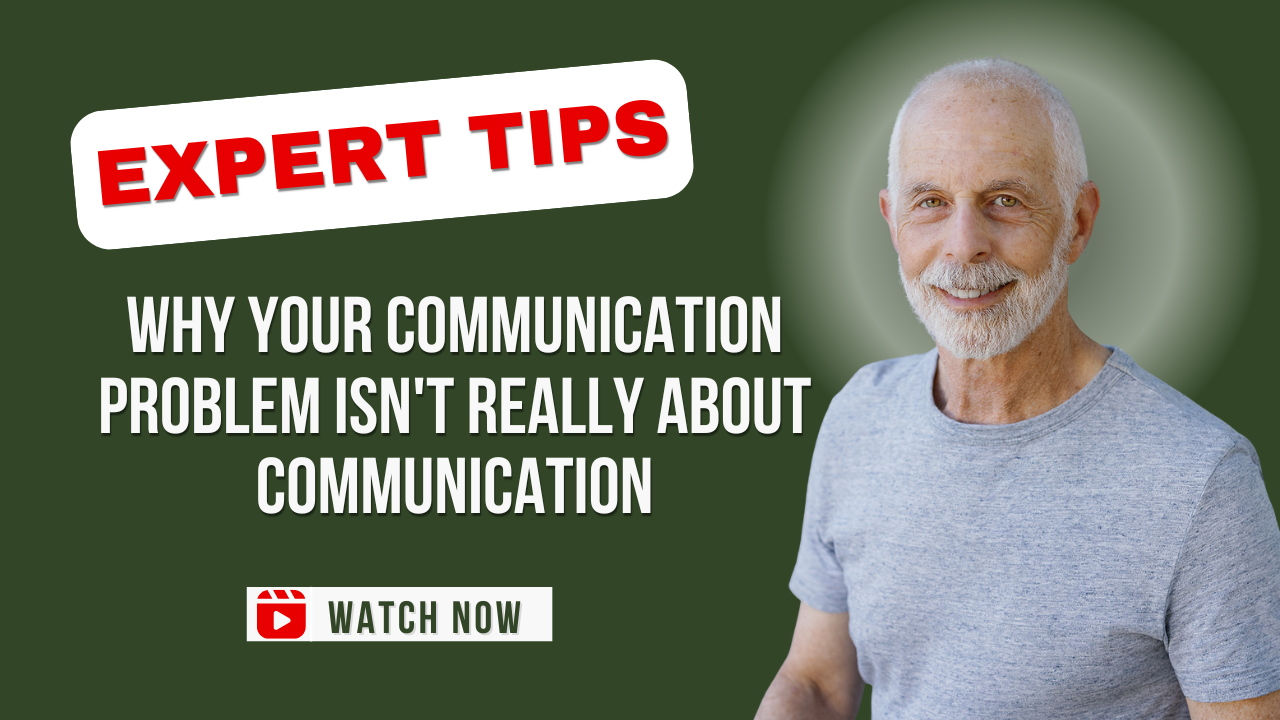about something I see almost daily in my practice, and it’s probably not what you think.
Couples come to me saying they have a “communication problem.” And technically, they’re right—they aren’t talking, or when they do talk, it goes sideways fast. But here’s what most people miss: the communication breakdown is almost never the real problem. It’s a symptom of something deeper that’s happening beneath the surface.
Let me explain why:
→ Most relationship communication issues stem from nervous system dysregulation, not lack of talking skills
→ Partners often have opposing regulation strategies (shutdown vs. fight) rooted in childhood coping mechanisms
→ Real solutions focus on learning new ways to regulate your nervous system while staying connected
→ You don’t necessarily need to talk more—you need to regulate better
But Here’s What Most People Miss:
→ Telling someone to “communicate better” is like telling someone having a panic attack to “just calm down”—their nervous system is already hijacked
→ Your partner’s “annoying” response pattern (shutting down, getting loud) was once a survival strategy that worked
→ Self-criticism about your patterns actually makes the dysregulation worse, not better
What We’re Covering: This piece walks through the real mechanics of why couples get stuck in communication loops, what’s actually happening in your body during these moments, and—most importantly—what you can do about it that doesn’t involve just “talking more.”
I’m drawing from decades of work with couples in pain, and I’ll show you why the conventional advice often misses the mark.
The Couple That Couldn’t Talk (But It Wasn’t About Talking)
Let me tell you about Helen and Nance. When they first came to see me, they looked exhausted. Helen had this tight-lipped frustration—the kind that comes from years of hitting a brick wall. Nance sat slumped, already bracing for what was coming.
Their presenting problem? “We can’t communicate.”
They weren’t wrong. Nance would shut down whenever Helen tried to discuss anything difficult. Sometimes he’d freeze completely. Other times he’d quietly leave the room. Helen’s response? She’d get louder, follow him, voice rising: “Why can’t you talk to me? Why can’t you talk to me?”
Nance would eventually muster: “Because you’re so aggressive. I feel attacked.”
Helen: “I don’t want to be that way!”
Round and round they’d go.
By the time they reached my office, they’d both given up. The house was quiet—but it was the hollow quiet of disconnection, not peace.
Now, most traditional therapy would focus on communication skills. Active listening techniques. “I” statements. Maybe some scripts for difficult conversations.
All of that can be useful. But with Helen and Nance, it would’ve been like handing a manual on advanced driving techniques to someone whose car won’t start. We needed to look under the hood first.
What’s Really Happening: Your Nervous System Is Running the Show
Here’s the piece that changes everything once you understand it: Both Helen and Nance were regulating their central nervous systems the only way they knew how.
That’s it. That’s the hidden issue.
Nance grew up in a house where his dad yelled at his mom. A lot. It scared him as a kid. His mom, meanwhile, was critical—always finding what was wrong, never satisfied. What was Nance supposed to do as a child? He couldn’t fix it. He couldn’t stop it. So he learned to go to his room, read books, play video games, and shut out the chaos. He learned to ignore the criticism from his mom and the coldness from his dad.
And here’s the thing—it worked. That strategy helped him survive. It helped him cope with pain he couldn’t do anything about. I’d bet money that at some point early on, maybe he tried expressing himself. Maybe he reached out. And it didn’t go well. So his nervous system learned: shutdown equals safety.
Helen’s story was different but equally powerful. Her dad worked constantly. Her mom ran everything and seemed to accept this distant marriage as just “the way things are.” Helen had a close relationship with her mom but almost none with her dad. She watched her mother’s loneliness and made herself a promise: I will never have the kind of marriage my mother had. I will never be that lonely in my relationship.
Fast forward to Helen and Nance’s marriage. What happens when disconnection threatens?
Nance’s nervous system, shaped by years of childhood conditioning, says: “Danger. Shut down. Go internal. That’s how we stay safe.” Immobilization defense.
Helen’s nervous system, equally conditioned by her childhood, says: “Danger. Do NOT let this turn into my parents’ marriage. Fight for connection. Get louder.” Mobilization defense.
You see the problem? Nance shuts down, which triggers Helen’s deepest fear of ending up like her mom. Helen gets louder, which triggers Nance’s childhood experience of his dad yelling and his mom criticizing. Nance shuts down harder. Helen pushes harder. Both are dysregulating each other while desperately trying to regulate themselves.
Neither one is choosing this consciously. Neither one is being “difficult.” They’re both running deeply ingrained nervous system programs designed to keep them safe.
The Sympathetic and Immobilization Defense Patterns
Let me get a bit more technical here because understanding this changes how you approach the whole thing.
When we perceive threat—and for many couples, conflict or disconnection is perceived as threat—our autonomic nervous system takes over. You’ve probably heard of fight-or-flight. That’s your sympathetic nervous system kicking into gear. But there’s also freeze, which is more of an immobilization response.
Helen’s Pattern – Mobilization Defense: Her sympathetic nervous system activates. Heart rate goes up. Voice gets louder. She’s in fight mode (not so much flight). From her perspective, she’s fighting for the relationship. She’s trying to get her husband to engage in a way she never got with her dad. In her body, silence equals abandonment equals mom’s loneliness. So her system mobilizes to prevent that outcome.
Nance’s Pattern – Immobilization Defense: His system goes into shutdown mode. Heart rate might actually slow. He freezes. Words become impossible. From his perspective, he’s trying to avoid the criticism and yelling he experienced as a kid. In his body, engaging during conflict equals pain. So his system immobilizes to prevent that outcome.
Both are trying to regulate. Both are trying to protect themselves. And both strategies, ironically, dysregulate their partner.
What Most Therapists Miss: Conventional communication advice assumes both people are in a regulated state where they can access their prefrontal cortex—the part of the brain that does rational thinking, empathy, and communication. But when you’re in fight-or-flight or freeze, you literally don’t have full access to those capabilities. Your nervous system has hijacked the show.
Telling Nance to “just talk” when he’s in shutdown is like telling someone who’s frozen in a trauma response to “just move.” Telling Helen to “calm down and lower your voice” when her system is mobilized to fight for connection is equally futile.
Why Beating Yourself Up Makes It Worse
Here’s something I tell every couple I work with, and it’s something Helen and Nance needed to hear:
When we’re dealing with each other in ways that don’t work, it’s usually because we don’t know any other way.
Read that again.
The self-criticism many people heap on themselves—”Why do I keep doing this? What’s wrong with me? I should be better than this”—comes from a false belief that you should have known better.
No. What you’re doing made perfect sense at some point in your life. It was adaptive. It worked. Your nervous system learned it well because it kept you safe.
The problem isn’t that you’re broken or stupid or bad at relationships.
The problem is that your childhood coping strategy is still running the show in your adult relationship, and it’s not working anymore in this new context.
Beating yourself up actually makes the dysregulation worse. Shame and self-criticism activate stress responses in the body. So now you’re not just dealing with the original trigger—you’re also dealing with the shame spiral on top of it. Your nervous system has even more to cope with.
Learning New Ways to Regulate (While Staying Connected)
So here’s the good news, and this is what I’m most passionate about: We can learn new ways to regulate our nervous systems.
You are not doomed to repeat these patterns forever. Your nervous system is adaptable. We can learn new tricks.
The goal isn’t to eliminate your stress responses—you’re a human being, and some level of activation is normal and healthy. The goal is to expand your window of tolerance so you can stay present with your partner even when things get difficult.
For someone like Nance (the shutdown pattern): The work is learning that he doesn’t have to shut down completely to stay regulated. There are other ways to manage his discomfort without disconnecting entirely. This might look like:
→ Learning to notice the early signs that shutdown is coming (body awareness)
→ Practicing staying present for just 30 seconds longer than feels comfortable
→ Developing language to name what’s happening: “I’m noticing I want to leave right now, but I’m going to try to stay”
→ Understanding that his shutdown, while protective for him, dysregulates Helen
For someone like Helen (the fight pattern): The work is learning that she can stay regulated without escalating. There are ways to pursue connection that don’t involve raising her voice or pushing harder. This might look like:
→ Recognizing when her system is starting to mobilize (racing heart, rising voice)
→ Pausing to take a few breaths before continuing
→ Naming her fear directly: “I’m scared we’re disconnecting” instead of “Why won’t you talk to me?”
→ Understanding that her pursuit, while coming from good intentions, dysregulates Nance
The Gold Medal: Co-Regulation Here’s what becomes possible once both partners learn new regulation strategies: you can actually start to help regulate each other’s nervous system.
When Helen can stay calm, her calm nervous system sends a signal to Nance’s nervous system: “It’s safe here. You don’t have to shut down.” When Nance can stay present without shutting down, his presence sends a signal to Helen’s nervous system: “I’m not leaving. You don’t have to fight for connection.”
This is called co-regulation, and it’s one of the most beautiful things that happens in healthy relationships. Your nervous systems start working together instead of against each other.
And then—voila—there’s communication. Real communication. Not forced scripts or techniques, but actual connection happening because both nervous systems are regulated enough to allow it.
Three Common Mistakes Couples Make
Mistake #1: Thinking More Talking Will Fix It
I can’t tell you how many couples come in saying they need to “communicate more” or “talk things through better.” Sometimes, yes, you need better communication skills. But often what you actually need is better regulation skills. Talking when you’re dysregulated just means you’re having a dysregulated conversation—which usually makes things worse, not better.
Mistake #2: Trying to Logic Your Way Out
When your nervous system is activated, your prefrontal cortex (the logical, rational part of your brain) is offline. Trying to reason with yourself or your partner in that moment is like trying to run a computer program when the power’s out. First, you need to get the power back on—which means regulation.
Mistake #3: Blaming Your Partner’s Pattern
It’s so easy to see your partner’s pattern as “the problem.” If only Nance would talk more. If only Helen would stop yelling. But both patterns are symptoms of the same underlying issue: nervous system dysregulation rooted in childhood adaptation. Neither person is the villain. You’re both stuck in a dance where each person’s dysregulation triggers the other’s.
What Actually Helps: Practical Steps
Based on working with hundreds of couples over decades, here’s what actually makes a difference:
Step 1: Develop Awareness of Your Own Pattern You can’t change what you’re not aware of. Start noticing:
→ What does it feel like in your body when you start to go into your pattern?
→ What triggers tend to activate it?
→ What are the early warning signs before you’re fully dysregulated?
Keep a simple log for a week. Just notice. No judgment. “I noticed I started to shut down when…” or “I noticed my voice got louder when…”
Step 2: Learn to Self-Regulate This is the skill that most people never learned growing up. Simple practices include:
→ Box breathing (4 counts in, 4 hold, 4 out, 4 hold)
→ Placing your hand on your heart or stomach
→ Going for a short walk
→ Splashing cold water on your face
→ Progressive muscle relaxation
Find what works for your nervous system. Some people need to move (walk, stretch). Some people need to ground (breathing, body awareness). Experiment.
Step 3: Practice Staying Present Just a Little Longer
Don’t try to completely override your pattern overnight. That’s too big a leap. Instead, if you normally shut down after 30 seconds of conflict, try staying for 45 seconds. If you normally escalate within 2 minutes, try staying regulated for 2 minutes and 15 seconds.
Small increments. You’re building new neural pathways. That takes repetition and time.
Step 4: Communicate About Your Pattern (When You’re Regulated)
Have a conversation with your partner when you’re both calm. Not during conflict. Talk about your patterns.
“When I feel criticized, my instinct is to shut down. I learned this as a kid. I’m working on it, but I need you to know it’s not about you—it’s my nervous system trying to protect me.”
“When I feel disconnection starting, my instinct is to pursue harder and get louder. I learned this from watching my parents. I’m working on it, but I need you to know I’m actually scared, not angry.”
This kind of vulnerability, shared from a regulated state, builds understanding and compassion.
Step 5: Create Repair Rituals
You will dysregulate. You will fall back into old patterns sometimes. That’s normal. That’s being human. What matters is repair.
Develop a simple ritual for after things go sideways:
→ “Can we try that again?”
→ A specific hand gesture that means “I need a break but I’m coming back”
→ A brief hug or physical connection before talking
→ A shared phrase like “We got stuck in the pattern, didn’t we?”
Repair is more important than perfection.
When Professional Help Makes Sense
Look, I’m a therapist, so you might think I’m biased here. But there are specific situations where professional help isn’t just useful—it’s crucial:
When to Consider Therapy:
→ You’ve been stuck in the same pattern for months or years with no improvement
→ One or both partners experienced significant childhood trauma
→ There’s been infidelity, addiction, or other major betrayals
→ Either partner has mental health issues (depression, anxiety, PTSD) that complicate the dynamic
→ You’ve tried self-help approaches and they’re not creating change
→ The relationship is affecting your physical health, work, or parenting
A skilled couples therapist who understands nervous system regulation can:
→ Help you identify your specific patterns more clearly than you might on your own
→ Provide real-time coaching during difficult conversations
→ Offer tailored regulation strategies based on your unique nervous systems
→ Address underlying trauma that’s fueling the patterns
→ Hold hope for you when you can’t hold it for yourselves
What to Look For in a Therapist:
→ Specialization in couples therapy (not just individual therapy)
→ Training in attachment theory, nervous system regulation, or trauma-informed care
→ Understanding that both partners are in pain, not that one is “the problem”
→ Focus on the relationship dynamic, not just individual communication skills
→ Ability to create a safe space for both partners
The Evolution Helen and Nance Experienced
Let me tell you how things turned out for Helen and Nance, because their story illustrates what’s possible.
They developed what I call “emotional muscle”—the ability to stay present with discomfort without immediately reaching for their old coping strategies. Nance learned he could feel anxious and stay in the conversation. Helen learned she could feel scared of disconnection and not escalate in response.
They practiced. A lot. It wasn’t linear. Some weeks were better than others. But gradually, something shifted.
Nance started saying things like, “I notice I want to leave right now, but I’m going to sit with this for another minute.” Helen started saying things like, “I’m feeling that panic again—the one where I think you’re checking out—but I’m going to take a breath instead of raising my voice.”
They learned to name what was happening in their bodies. They learned to understand each other’s patterns with compassion instead of blame. They learned, gradually, to co-regulate—to help soothe each other’s nervous systems instead of triggering them.
Most importantly: They learned they didn’t have to be victims of their families of origin. Nance could evolve beyond his childhood shutdown strategy. Helen could evolve beyond her childhood pursuit pattern.
They found that beating themselves up was not only unhelpful—it was inaccurate. They weren’t failing at something they should have known. They were learning something new. Big difference.
Why “Just Talk More” Isn’t the Answer
This might sound counterintuitive coming from a therapist, but talking isn’t everything. In fact, sometimes talking is exactly the wrong prescription.
If you’re dysregulated, talking will likely be dysregulated talking—which means more misunderstanding, more hurt, more disconnection. You need regulation first, connection second, communication third.
Here’s what I tell couples: You need to be able to be present with each other in ways that don’t involve words. You need to rebuild safety in your nervous systems around each other. Sometimes that happens through:
→ Being in the same room doing separate things peacefully
- Physical touch without talking (hand-holding, hugging)
- Parallel activities (cooking together, walking together)
- Eye contact and presence
- Small gestures that signal “I’m here” and “You matter”
These non-verbal forms of connection can actually be more regulating than conversation, especially when you’re learning new patterns.
Once your nervous systems feel safe together again, communication becomes easier. Natural, even. You don’t have to force it or script it. It flows because the underlying foundation—regulation and co-regulation—is there.
Moving Forward
If you’re reading this and recognizing your own pattern—or your partner’s—take a breath. Seriously. Right now. Take a breath.
What you’re experiencing isn’t a character flaw. It’s not evidence that your relationship is doomed. It’s not proof that you or your partner are broken.
It’s evidence that you’re human beings with nervous systems shaped by your experiences, doing your best to stay safe in relationships.
The patterns you developed made sense. They served you once. They protected you.
And now, with awareness and practice and probably some patience and maybe some professional support, you can learn new patterns. You can expand your window of tolerance. You can develop the emotional muscle to stay present with each other even when it’s uncomfortable.
Helen and Nance did it. Hundreds of other couples I’ve worked with have done it. You can do it too.
This is what I’m passionate about—helping couples understand that communication problems are usually regulation problems in disguise, and that there’s a path forward that doesn’t require you to somehow become a different person or erase your past.
You just need to learn some new tricks. Your nervous system is ready. The question is: are you?
About the Author: Todd Creager has spent decades working with couples navigating infidelity, disconnection, and communication breakdowns. His approach focuses on understanding the deeper nervous system dynamics that drive relationship patterns, helping partners move from dysregulation and pain toward co-regulation and authentic connection. He specializes in helping couples who feel stuck in patterns that seem impossible to change.
Methodology Note: The insights in this article are drawn from direct clinical experience with hundreds of couples over multiple decades, integrated with current research on nervous system regulation, attachment theory, and trauma-informed care. The case examples are composites designed to illustrate common patterns while protecting client confidentiality. The emphasis on nervous system regulation as foundational to communication is based on both practical observation in therapy sessions and emerging neuroscience research on how autonomic nervous system states affect relational capacity.
Making the world safe for love.










Reader Interactions